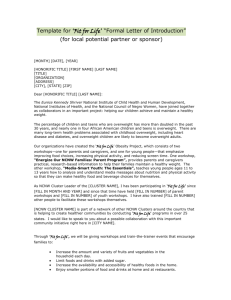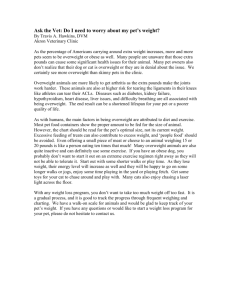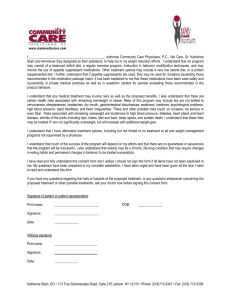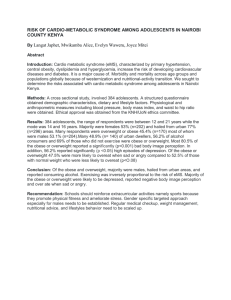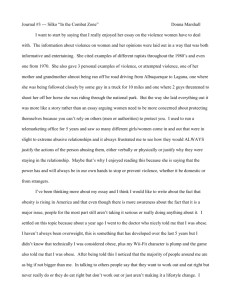The World Is Fat: New Dynamics Shifts in Patterns of The Nutrition
advertisement
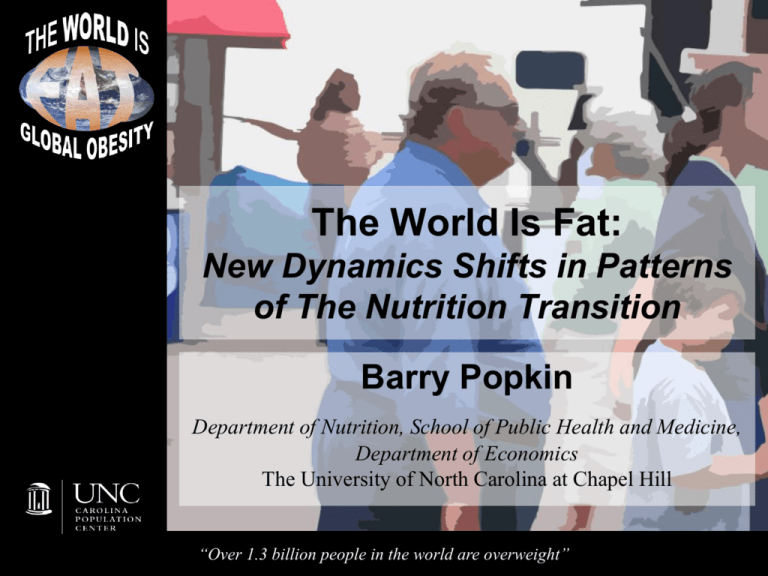
The World Is Fat: New Dynamics Shifts in Patterns of The Nutrition Transition Barry Popkin Department of Nutrition, School of Public Health and Medicine, Department of Economics The University of North Carolina at Chapel Hill “Over 1.3 billion people in the world are overweight” Outline: New Dynamics • Global Dynamics: The US is no longer be the nation with the highest BMI and overweight levels • Total Caloric Change: Eating Frequency(snacking), Caloric Beverages and Portion Sizing • The World is Flat and Fat: globalization has occurred for centuries • How do we proceed “Over 1.6 billion people in the world are overweight” Figure 1. Stages of the Nutrition Transition Urbanization, economic growth, technological changes for work, leisure, & food processing, mass media growth Pattern 1 Paleolithic man/ Hunter-gathers • Wild plants & animals • water • Labor intensive Lean & robust, high disease rate Low fertility, Low life expectancy Pattern 2 Settlements begin/ Monoculture period/ Famine emerges • Cereals dominate • water • Labor-intensive Nutritional deficiencies emerge, stature declines High fertility, high MCH mortality, low life expectancy Source: Popkin 2002 revised 2006. Pattern 3 Industrialization/ Receding Famine Pattern 4 Noncommunicable Disease • Starchy, low variety, low fat, high fiber • water • Labor-intensive work job/home • Increased fat, sugar, processed foods • caloric beverages • Shift in technology of work and leisure • Reduced fat, increased fruit, veg, CHO, fiber • Increase water, Reduce caloric beverage intake • Replace sedentarianism w/ purposeful activity MCH deficiencies, weaning disease, stunting Obesity emerges, bone density problems Reduced body fatness, improved bone health Accelerated life expectancy, shift to increased DR-NCD, increased disability period Extended health aging, reduced DR-NCD Slow mortality decline Pattern 5 Behavioral Change High Income vs. Transitional and Low Income Countries • Trend toward a higher BMI in higher income countries reaches back a century but major increase seen in the 1980’s to the present • In contrast, minimal obesity in most of developing and transitional world until the late 1980’s. It is again rapid changes in the past 20 years • Now at a point where across the globe in most countries obesity far exceeds undernutrition and the dynamics of energy balance changes are shifting upwards this gap rapidly “Over 1.6 billion people in the world are overweight” Mismatch: Our Biology Clashes with Modern Technology Biology Technology Sweet preferences cheap caloric sweeteners, food processing benefits Thirst and hunger/satiety mechanisms not linked Caloric beverage revolution Fatty food preference Edible oil revolution-high yield oilseeds, cheap removal of oils Desire to eliminate exertion Technology in all phases of movement/exertion “Over 1.6 billion people in the world are overweight” Patterns Of Overweight & Obesity Globally For Nationally Representative Samples (Percentage overweight + Obese) <10% 10-20% 21-30% 31-40% 41-50% >51% Arctic Ocean Arctic Ocean North Pacific Ocean Indian Ocean South Pacific Ocean South Atlantic Ocean .1 BMI Distribution Shifts among Mexican women 18-49 y (National Surveys 1988, 1999 y 2006) 1999 .04 .06 2006 0 .02 Kdensity BMI .08 1988 10 15 20 25 30 35 40 BMI (Kg/m2) From Juan Rivera 45 50 55 60 65 Annual Absolute Change in the Prevalence of Overweight and Obesity in 9 Countries from 1985/1995 to 1995/2006 (BMI≥25.0 for adults; IOTF equivalent for children) 2.0 1.9 Annual percentage change 1.7 Children Adult Males Adult Females 1.5 1.3 1.2 1.1 1.0 1.0 1.0 0.9 1.0 1.0 0.9 0.8 0.7 0.9 0.8 0.6 0.5 0.5 0.5 0.5 0.4 0.4 0.3 0.1 0.1 0.1 0.0 -0.02 -0.5 Australia U.K. U.S.A. Brazil Russia China Indonesia Vietnam Mexico Popkin (2007) nature reviews, cancer 7:61 The Shift in BMI levels at the 95th Centile for Females Aged 30 45 42.5 2.7 increase 37.7 39.8 35 3.5 increase 5.4 increase 30.7 29.7 34 32.3 26.3 27.2 27.7 25 20 15 10 5 United States Australia Popkin, AJCN in process-not for distribution/use United Kingdom 1991 2003 1995 1980 2000 1989 1980 2003-06 1988-94 0 1971-75 BMI 30 37.5 2006 35.2 1997 40 China The Shift in BMI Levels at the 95th Centile for Children Aged 6 30 24.8 25 21.6 22.2 21.6 20.1 BMI 20 19.8 20.1 1995 2003 18.8 18 5 increase 19.8 15 10 5 NA 0 1971-75 1988-94 2003-06 United States 1985 1995 Australia Popkin, AJCN in process-not for distribution/use 2007 United Kingdom 1991 1997 China 2006 Australian Youth Gain Fat, Shift Body Shape Based on the research of Olds (2009) EJCN 1-13. “Over 1.6 billion people in the world are overweight” The consequences vary by race-ethnicity: Body fat composition in the East vs the West (Yajnik & Yudkin 2004) The burden of disease is shifting rapidly towards the poor. • By burden, we refer to the greater prevalence of poor diets, sedentarianism, obesity, NR-NCD’s among the poor • Brazil is the only country where a significant obesity reduction among the rich and increase among the poor is seen (only for adult females). • Studies on the shifts in diet among various income groups in China point towards a similar shift occurring there in 10-15 years • Monteiro and Popkin series of cross-sectional studies to show similar patterns acrsoss the globe of greater obesity emerging among the poor. “Over 1.6 billion people in the world are overweight” Sources of Major Global Dietary Shifts • Across the globe: large increases in consumption of caloric beverages and increasing snacking • Lower income countries: increased edible oil, animal source foods are another source of kcal increase • Globally, we find an increased intake of ultra processed foods, refined carbohydrates • Globally, we find a reduced intake of fruits and vegetables and legumes • Globally, we find a reduced preparation time, increased use of precooked foods “Over 1.6 billion people in the world are overweight” From Traditional to Modern Meals From Traditional to Modern Snacking From Traditional to Modern..... Marketing of Food Sweetness Many think that we have inborn biological wisdom but how and why and what role this plays in our food preferences has not achieved consensus. Because sweet foods are naturally good and are safe sources of energy and nutrients, adaptive evolutionary development has resulted in a preference for them. Of the five most widely acknowledged tastes, three generally signal acceptance (sweet, salty, and umami*), while two generally signal avoidance(sour and bitter). These early responses are modified by life experiences,producing adult tastes preferences. “Over 1.6 billion people in the world are overweight” Sweetness Preference was Essential to Survive: Huge Shift in Amounts, Energy Density “Over 1.6 billion people in the world are overweight” Sweetness and Effects on Eating Preferences • Expose infants to sweetness and find several years later desire exists for sweet foods • Studies on mice, primates replicate this • Virtually no long-term studies on exposure to sweetness and sweet foods and how it effects our needs and eating patterns subsequently . “Over 1.6 billion people in the world are overweight” Increases in total calories from added sugar are greatest among top 20% of population Q1 Q2 Q3 Q4 Q5 Total 1965 60 161 262 396 701 316 1977 32 114 195 299 560 240 1989-91 29 113 206 324 616 258 1999-00 62 193 321 491 959 406 2001-02 59 176 300 464 882 376 2003-04 56 172 295 646 896 377 -8.3% Duffey & Popkin(2008) AJCN 88(suppl):1722S “Over 1.6 billion people in the world are overweight” +27.7% What are the implications of eating food and drinking water on energy balance? General Properties • Hunger – Feeding Sensations that promote attainment of minimal food energy needs • Thirst – Drinking Sensations that promote attainment of minimal hydration needs • Energy Excess Stored • Water Excess Excreted • Energy Deficit: Die in 1-2 months • Water Deficit : Die in 2-4 days “Over 1.6 billion people in the world are overweight” Biology vs Technology: Shift from Water to Caloric Beverages with No Food Calorie Compensation “Over 1.6 billion people in the world are overweight” Energy Intake (N=40) 4000 Fat Protein (Coc onut) (Dairy ) Carbohydrate 3500 (Waterm ellon) 3000 K cals 2500 2000 * * L iq u i So lid * 1500 1000 500 0 “Over 1.6 billion people the world are overweight” Mourao, .. in (2007). "Effects of food form..." IJO:31(11): 1688-95. L iq u i So lid L iq u i So lid Remarkably Short History for Caloric Beverages: Might the Absence of Compensation Relate to This Historical Evolution? Earliest possible date Definite date US Soda Intake 52/gal/capita (2004) Modern Beverage Era 10,000 BCE - present Pre-Homo Sapiens 200,000BCE - 10,000 BCE Origin of Humans US Coffee Intake 46 gal/capita (1946) Juice Concentrates (1945) US Milk Intake 45 gal/capita (1945) Coca Cola (1886) Pasteurization (1860-64) Carbonation (1760-70) Liquor (1700-1800) Lemonade (1500-1600) Coffee (1300-1500) Brandy Distilled (1000-1500) (206 AD) Tea (500 BCE) Wine, Beer, Juice (8000 BCE) Wine (5400 BCE) Beer (4000 BCE) Milk (9000 BCE) 2000 BCE AD 0 BCE 100000 BCE 10000 BCE 200000 BCE Homo Sapiens 200000 BCE Beginning of Time Water, Breast Milk Global Trends • Minimal published data • Mexico-see below. “Over 1.6 billion people in the world are overweight” Daily Beverage Consumption Trends of Mexican Children, 1999-2006 Sodas Sweetened Juice Drinks Whole Milk Other 400 Calories per capita (kcal) 343 45 297 300 200 16 190 165 226 17 100 0 26 110 116 24 37 8 1999 19 2006 Children aged 1-4 158 86 17 38 55 1999 2006 Children aged 5-11 Note: Sweetened juice drinks include 100% fruit juice with sugar added and agua fresca (water, juice, sugar). Sodas include carbonated and noncarbonated sugar bottled beverages. Source: Barquera et al (2008)J Nutr 138: 2454-61. Beverage Consumption Trends of Mexican Adolescents and Adult Women, 1999 and 2006 High sugar High calorie low benefit 400 366 349 Kcal per day 350 Low calories 7 4 109 300 120 250 200 150 154 145 7 12 47 225 100 50 250 52 100 81 0 1999 2006 1999 2006 Year 12-18 years of age 19-49 years of age Note High sugar is composed of mainly soft drinks, sweetened juices, agua frescas and alcohol. High calorie and low benefit is mainly whole milk. Low calories are slightly sweetened coffee and skim milk Source: Barquera et al (2008)J Nutr 138: 2454-61. United States: a large shift toward caloric beverages • Milk-long-term decline since 1945 • Major increases in sugar-sweetened beverages since the 1980’s, some leveling off in last 4 years • Juice intake, alcohol show important increases “Over 1.6 billion people in the world are overweight” Long Steady Decline of Total Milk Intake “Over 1.6 billion people in the world are overweight” Sugar-sweetened beverage Consumption Trends (Soda/Fruit Drinks) (kcal/day), Nationally Representative “Over 1.6 billion people in the world are overweight” Juices • Several studies from Australia, the US and Spain show a comparable effect of juices on energy intake, weight gain and CVD “Over 1.6 billion people in the world are overweight” Juice Consumption Trends (Kcal/Day), Nationally Representative “Over 1.6 billion people in the world are overweight” Alcohol Consumption Trends(kcal/day), Nationally Representative “Over 1.6 billion people in the world are overweight” Water • Water: 60% of our body, essential for life • Water consumption measurement is fairly crude with minimal effort on this critical nutrient • Water research: very limited. • Review: adding water to the diet alone or to replace sugar-sweetened beverages, juice, milk and diet beverages • Ongoing random controlled trials in the US and Mexico on possible benefits of water “Over 1.6 billion people in the world are overweight” Difference in Total Energy Intake when Juice or Milk Displace Water Almiron Roig (2003) adults DellaValle (2005) women Almiron Roig (2003) men Almiron Roig (2003) women DellaValle (2005) women Hagg (1998) kids 4-7 Weighted Average (Juice & Milk) Change (%) in Energy Intake with Added Water †P<0.05 Popkin,et al, under review; Daniels and Popkin, under review; “Over 1.6 billion people in the world are overweight” Differences in Total Energy Intake when HFCS or Sucrose Sweetened Beverages Displace Water (6 kids not shown; only sig adults shown out of 19 total) Almiron Roig (2003) (b) DellaValle(2005) (w) Flood (2006) (w) Flood (2006) (w) Mattes (1996) (L) Rolls (1990) (w) Rolls (1990) (b) Van Wymelbeke (2004) (L) Weighted Average (kids) Weighted Average (adults) †P<0.05 (b) preload before meal (w) preload with meal (L) long study (2+meals) Change (%) in Energy Intake Popkin,et al, under review; Daniels and Popkin, under review; Differences in Total Energy Intake When Diet Beverages Displace Water (6 kids; 19 adult comparisons; sig shown) Birch (1989) (b) Lavin (1997) (L) Birch (1989) (b) Weighted Average (kids) Weighted Average (adults) †P<0.05 (b) preload before meal (w) preload with meal (L) long study (2+meals) Change (%) in Energy Intake Popkin,et al, under review; Daniels and Popkin, under review; “Over 1.6 billion people in the world are overweight” Total Caloric Intake is a Combination of Three Components • Total caloric intake = f(Portion Size x Eating Frequency x energy density of the portion) • Portion sizes ↑: US, UK, Germany, other countries • Eating Frequency ↑↑: large increase documented in few countries, seeing new global increases. Snacks are significantly greater energy density • Energy density ↑↓ : small increases in food energy density, declines in meal and snack energy density are significant when correctly combine food intake with all beverages consumed “Over 1.6 billion people in the world are overweight” Portion sizes • Portion size increased for hamburgers, cheeseburgers (for kids only), pizza and Mexican dishes • The pizza increase in kcal portion size was particularly large (176 kcal for kids, 216 for adults). • Snack foods: portion size down as frequency went up in last decade • Desserts, drinks, french fries down slightly “Over 1.6 billion people in the world are overweight” Trends in Overall Portion Sizes in the United States, Nationally Representative Adults Aged 19 and older “Over 1.6 billion people in the world are overweight” Trends in The Energy Density of Food And Beverages from Food plus Beverages at Meals and Snacking Occasions In the United States (kcal/gram) 1989-91 1994-98 2003-6 0.92 0.98 0.99 1.01 0.76 0.98 0.24 0.26 0.26 0.26 0.22 0.28 0.27 0.28 1 0.93 0.89 1.85 1.73 2 1.78 2.83 2.71 2.81 1.79 Kcal/gram 3 2.77 1977-78 0 Snacking food Meals food Snacking beverages Source : Piernas and Popkin, unpublished data Meals beverages Total snacking Total meals Snacking • Significant increases in 1990’s and again in the new Millenium in the United States • China—tripling in 2004-6 period. Expect great changes in the next several years. • Few small studies across the globe “Over 1.6 billion people in the world are overweight” The Likelihood of Snacking Across All Individuals Aged 2 and Older, China 1991-2006 2004 1991 2006 0.5 Proportion snacking over 3 days 0.44 0.4 0.34 0.32 0.29 0.3 0.25 0.20 0.2 0.15 0.10 0.1 0.06 0.07 0.07 0.08 0.08 0.08 0.10 0.11 0.05 0.05 0 low Middle Income high Low Middle Education Source: CHNS 1991,2004 and 2006; Adjusted for income, education, urban, gender and age (2-18,19-59,60+) Zhihong Wang et al (2008) Asia Pac J Clin Nutr 17:123 high The Percentage of Total Energy Intake from Snacks, Chinese 1991-2006 1991 2004 2006 10 8.4 8 6 4.3 4 3.2 3.1 2.5 2 1.5 1.3 1.4 0.5 0.7 0.6 1.6 1.5 0.5 0.8 1.0 0.8 0.8 45+ Total 0 2-6 7-12 13-18 19-44 Age (years) Does the physiological basis for eating exist any more? Continuous caloric intake is becoming the norm. Percentiles of US Individuals Consuming Meals Plus Snacks 1977-78 1994-98 2003-2006 30 25 15 10 5 0 1.0 1.5 2.0 2.5 3.0 3.5 4.0 4.5 5.0 5.5 6.0 6.5 7.0 7.5 8.0 8.5 9.0 9.5 10.0 10.5 11.0 11.5 12.0 12.5 13.0 13.5 14.0 14.5 15.0 15.5 16.0 16.5 17.0 17.5 18.0 18.5 19.0 19.5 20.0 20.5 21.0 21.5 22.0 22.5 23.0 Percent 20 Number of meals plus snacks averaged over two days Source : Popkin and Duffey, unpublished data Fat Preference Key for Survival: Technology, Marketing have Utilized this Preference for Fatty Food “Over 1.6 billion people in the world are overweight” Fatty Foods • Fatty foods: smoother, affects taste in many ways • Elsewhere I have written about and documented the very large increases in vegetable oil (edible oil) consumption across Asia, Africa, the Middle East and parts of Latin America. “Over 1.6 billion people in the world are overweight” Edible Oil Consumption Still Rising in China (grams per day per capita) Year 1989 1997 2006 Poorest (lowest income tertile) 11.8 26.5 30.8 15 29.7 30.9 Richest (highest income tertile) 17.4 31.3 30.9 Average for total adult population 14.8 28.9 30.9 % of all calories per capita from edible oil 4.9 11.2 12.4 Middle income tertile Source: China Health and Nutrition Survey for adults aged 20-45 “Over 1.6 billion people in the world are overweight” The Predicted Probability of Consuming Excessive Fried Foods in Chinese Urban Residents, 1991 and 2004 0.6 1991 2004 0.5 Probability 0.51 0.42 0.4 0.4 0.3 0.51 0.49 0.37 0.41 0.39 0.31 0.3 0.39 0.3 0.2 0.1 0 low Middle high Low Income Source: CHNS 1991 and 2004; Adjusted for socio-demographic factors Wang et al (2008) Asia Pac J Clin Nutr 17: 123 Note: excessive fried foods represents more than 20% of kcal from fried foods. Middle Education high Major Global Dietary Shifts • Increased animal source foods “Over 1.6 billion people in the world are overweight” Price Policies Are a Great Option: Price Elasticities of Demand Beef Urban China 2000 All China 1990 -.90 -1.04 Pork -.21 -.98 Poultry -.75 -.53 Fish -.37 -.81 S. Korea 1985 Livestock -.68 NA S. Korea 1962-92 Morocco 1969-85 -.49 -1.63 -.57 NA -1.07 -1.26 -.34 -.17 AIDS Demand Models Various Sources cited in Delgado & Courbois 1998; urban China 2000 figures from Yen, et al. 2004; S. Korea 1985 figures from Cranfield et al, 1998 “Over 1.6 billion people in the world are overweight” Real World Prices, 1990 US$ 500 100 kg Beef 400 300 1 MT Maize 200 100 kg Poultry 100 70-72 80-82 90-92 94-96 2020 AIDS Demand Models Various Sources Cited in Delgado & Courbois 1998 Fast Food Consumption • No studies address several key issues • First–is it the behavior of the consumer who selects fast food or the foods per se at the Fast Food restaurant? • Second, no random controlled trials or studies of what people consume at fast food places or studies that somehow separate the characteristics and potential selectivity of fast food vs sit down restaurants on behavior. • Third, enormous heterogeneity in consumption changes related to away-from-home eating. “Over 1.6 billion people in the world are overweight” The Struggle Over the Millenia to Eliminate Arduous Effort Could Not Foresee Modern Technology “Over 1.6 billion people in the world are overweight” From Traditional to Modern Household Production From Traditional to Modern Economic Work at Home From Traditional to Modern Leisure Shift In MET Hours per Week by Activity Among Chinese Women (18-55 Years Old) 500 Leisure activity Travel activity Domestic activity Occupational activity MET hours per week 450 400 350 300 250 200 0 1991 1993 1997 1997 Year Source: Ng ,Norton, Popkin (2009) SSM 68: 1305-14. 2000 2004 2006 The World is Flat and Fat: Globalization has Occurred for Centuries • Naïve idea that globalization is a phenomena of the past few decades • Consider how Columbus et al introduced from the Americas to the cuisines of the world: Chili peppers in Asia, Potatoes in Europe, and tomatoes in Italy are examples. Or noodles from Asia to Italy • Recent rapid acceleration in areas such as communications technology, transportation systems, distribution technologies affect how we eat, move, drink. Think of Red Bull’s impact globally in 5 years vs coke in 70 years “Over 1.6 billion people in the world are overweight” How do we proceed? • Clearly action needed at all levels; however I believe the only way to produce concerted change is to look to the models of tobacco use, seat belt, other major public health changes • Regulations, taxation, mass education are key components • Examples: Mexico Beverage campaign, US Farm Bill, Brazil and Singapore schools • Current global economic crisis has slowed down many changes “Over 1.6 billion people in the world are overweight” Mexico Initiative on Beverages • Remove all whole milk, shifted now to 1.5% and later to skim milk all gov’t programs • Schools: working to ban all sugar sweetened beverages, provide safe water, allow water, low fat milk to be sold • Taxation being considered: tax added sugars in beverages per gram, fat in milk • National media effort–began Feb 25 with launch of Mex. Beverage Guidelines • Source:Rivera et al, Salud Publica Mex 2008;50:173-195 “Over 1.6 billion people in the world are overweight” Effects of Price Changes on Soda and Whole milk Consumption 10% increase in the price of soda 2.03 2.43 Soda 0 Poor 2 Rich Whole milk Soda 0 1 -6 -30 -8 -40 -70 Source: Barquera et al, (2008) J Nutr138: 2454-61. -16 -11.38 -14 -10.31 -12 -11.34 -60 -53.02 -50 -46.10 -10 -0.88 -4 -20 -1.24 -10 1 -2 -1.20 Whole milk -50.02 Change in consumption (mL/day) 10 2.07 Overall 10% increase in the price of whole milk Price changes and dietary intake in the US • CARDIA: in-depth 20-year cohort • Detailed dietary data linked by UNC team with food prices for each community over the same time period • Focus on prices of beverages and fast foods here “Over 1.6 billion people in the world are overweight” Methods: Price Elasticity of Demand • Elasticity= % change in demand % change in price • Own-price elasticity %Δ $ %Δ kcals %Δ Negative or kcals positive Negative • Cross-price elasticity % Δ $ “Over 1.6 billion people in the world are overweight” Combined 10% Change in Price Results in Greater Percent Change in Outcomes: 20 year longitudinal analysis of price and CARDIA cohort Soda Pizza Soda & Pizza Percent Change in outcome 0 -0.5 -0.3 -1 -1.5 -0.9 -1.1 -1.2 -1.1 -2 -2.5 -1.9 -2.3 -2.3 -3 -3.5 -4 -4.2 -4.5 Total Energy Body Weight Source: Duffey et al, manuscript 2009 not for distribution/use HOMA-IR Program and policy effectiveness: Are we ready for preventive action? Major research gaps exist. • Targets: sugary beverages is very clear as is the Media. Other foods are not as clear. • Macroeconomic options: price changes matter, governments subsidize wrong foods now • Regulations: TV advertising, other advertising, edible oil contents, school meals, school PE, etc • Reprints (pdf files) and citations can be found on www.nutrans.org. New book The World Is Fat (Penguin Press) published end of Dec 2008 “Over 1.6 billion people in the world are overweight” THE BOOK “The most serious epidemic ever is insidiously engulfing the world. Barry Popkin draws upon his decades of research and experience to describe its origins–and a set of potential solutions. Those interested in the future of mankind should read this book.” Walter Willett, author of Eat, Drink, and Be Healthy, and chair, Department of Nutrition, Harvard University Acknowledgements to My Many Key Collaborators: University of North Carolina faculty co-investigators in various or many studies: Linda Adair, Penny Gordon-Larsen, John Akin, Peggy Bentley, John Briscoe, Jane Brown, Barbara Entwisle, Kelly Evenson, Pam Haines, Gail Henderson, David Guilkey, Tom Mroz, Shu Wen Ng, Daniel Rodriquez, Anna Maria Siega-Riz, Yan Song, June Stevens, Deb Tate,Dick Udry, Namvar Zohoori Brazil: Carlos Monteiro Philippines: Wilhelm Fleiger, Florentino S. Solon, Others in the US: Suchi Ayala, Robert Black, George Bray, Ben Caballero, Walt Willett, China: Zhai Fengying, Du Shufa, Ge Keyou, Chen Chunming, Chen Xiaoshu Mexico: Simon Barquera, Juan Rivera, Sonia Hernandez Russia: Polina Kozyreva, Mikhail Kosolopov, late Michael Swafford, Alexander Baturin Students and postdocs: Past: Linda Adair, Colin Bell, Colleen Doak, Kiyah Duffey, Elena Glinskaya, Penny Gordon-Larsen, Xuguang Guo, Ningqi Hou, Lisa Jahns, Soowon Kim, Ying Liu, Mikhail Lokshin, Bing Lu, Kathleen Mctigue, Michelle Mendez, Keri Monda, Shu Wen Ng, Tuan Nguyen, Samara Nielsen, Sahasporn Paeratakul, Ruth Patterson, Kathleen Reidy, Marie Richards, Jodi Stookey, Nguyen Thang, Carrie Waller, Youfa Wang, Monica Yamamoto, Claire Zizza Current: Jessie Jones-Smith, Tracy Dearth-Wesley, Huijun Wang, Zhihong Wang, Daisy Zamora My right arms: Frances Dancy, Tom Swasey My Family And many coauthors of a range of papers important in my career “Over 1.3 billion people in the world are overweight”

